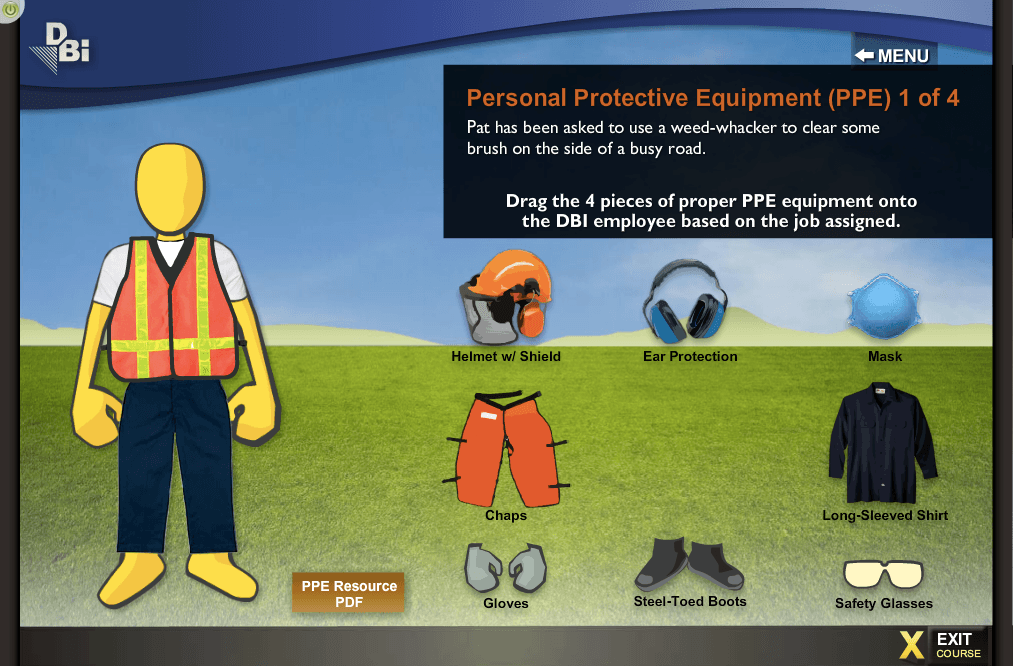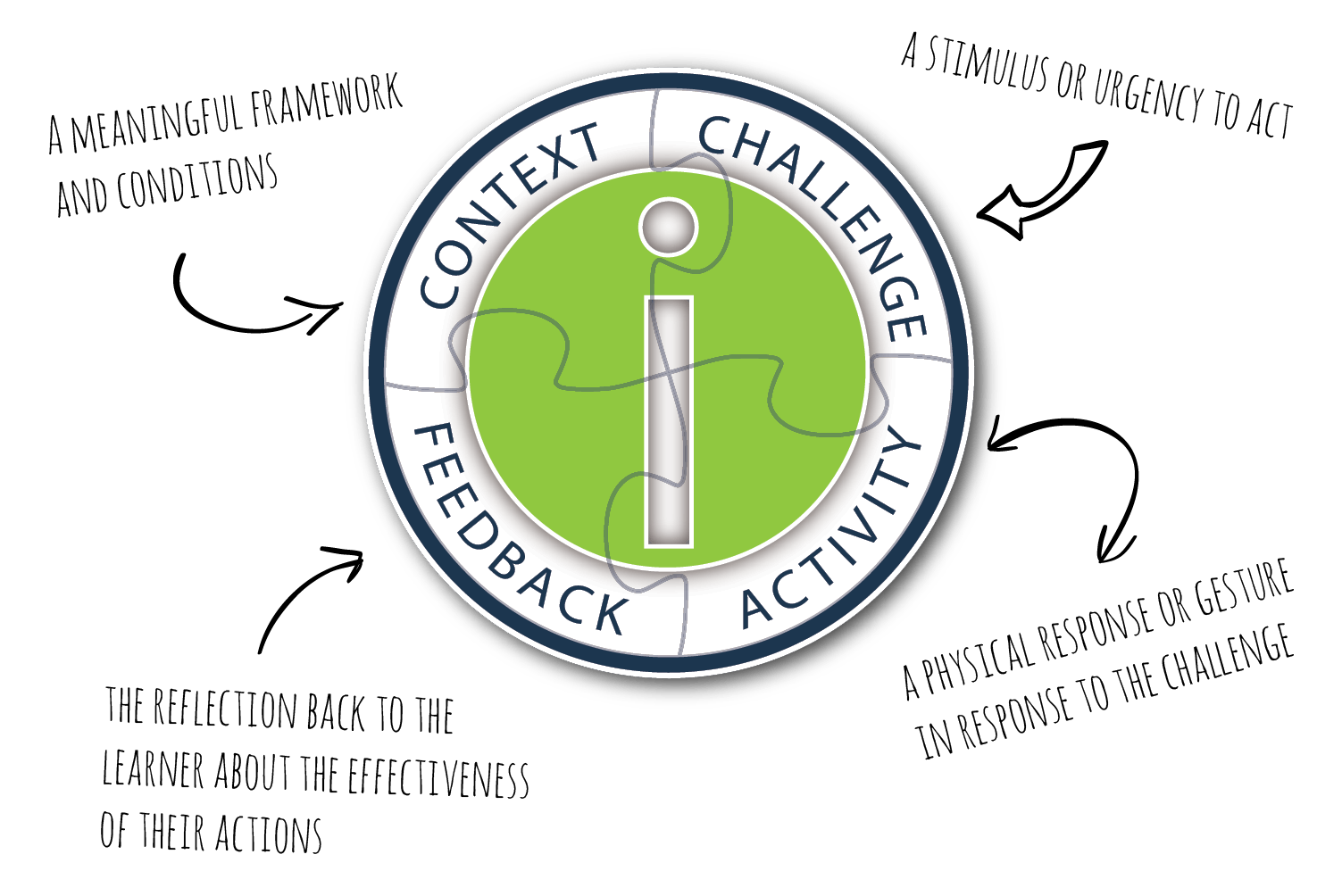Lens One: Interactive Learning
The CCAF Design Model framework for instructional interactivity, created by Dr. Michael Allen, is a hallmark of Allen Interactions. This interactive learning design model is learner-centric and focused on creating meaningful, memorable, motivational, and measurable eLearning or online training programs. First published in Michael Allen’s Guide to eLearning, this framework establishes 4 components—Context, Challenge, Activity, and Feedback—as the essential pieces of effective learner interactions. As an interactive learning framework for an Instructional Designer, this structure provides a reliable means to transform and elevate online teaching interactions.
CCAF Design Model: 4 Components
The CCAF Instructional Design Model [1] says that effective eLearning interactions require that the 4 components be balanced and integrated:
- Context
Provide a meaningful framework that identifies how this task or information is relevant and essential to the real world of the learner. - Challenge
Motivate the learner to engage with authentic intention through establishing meaningful risks, significant outcomes, and the potential for success. - Activity
Use gestures that correspond and evoke the real-life activities at the heart of the desired performance. - Feedback
Reflect back to the learners not only indicators of correctness but, more importantly, intrinsic and extrinsic indicators of how they can improve.
I’ve spent many years working with budding Instructional Designers to understand these elements and encourage them to use them in their design work. Frustration has been that the application of the 4 components sometimes remains fragmented. In truth, the CCAF Instructional Design Model is most valuable in the power of the sum of its parts rather than the individual pieces.
This is the first of a series that I hope will apply a fresh approach to understanding CCAF as a total package. I want to apply several lenses of importance to educators and trainers to reveal the broad flexibility and broad application potential of the CCAF Design approach.
The Power Of CCAF Vs. Levels Of Interactivity
It may seem preposterously circular to talk about the CCAF Design Model of Instructional Interactivity in terms of interactivity itself, but we need to do so in order to grasp the full revolutionary significance this model proposes.
The traditional way people talk about interactivity is through the well-known Levels of Interactivity [2] rubric that has circulated in various forms throughout the industry for years. In brief, this structures the world of interactivity into 4 levels:
- Level 1—Passive (no interaction): Process is strictly linear; may include simple images, video, audio, and test questions.
- Level 2—Limited participation: Limited control of simple interactions; may include animations, clickable menus, and drag-and-drop interactions.
- Level 3—Moderate interaction: Learner experience more customized and complex; simulations, stories, and branching scenarios.
- Level 4—Full immersion: Learners control the learning experience with more complex exercises and simulations.
The uselessness of this structure for an Instructional Designer is that it completely avoids active thinking on the part of the learner as a critical element of instructional interactivity. Instead, it simply captures the technical complexity of the solution, which may or may not have anything to do with its potential for creating performance change in the learner. In truth, any interaction that permits less than full immersion on the part of the learner is a failure. And the levels of interaction structure unaccountably categorizes “No Interactivity” as an acceptable level.
In the CCAF Design Model [1], the intention and outcome are that every interaction, regardless of technical complexity, should create full immersion, even if the physical structure underpinnings are quite simple.
I have a mantra that my students no doubt get tired of hearing: “Whatever you build, it’s just a multiple-choice question.”
While there are a few exceptions, the vast majority of online interactions will take the form of a multiple-choice or multiple-selection question: here are the various choices I am presenting for you to respond to; one or more are “correct,” the others are “wrong.”
CCAF allows us to make every single opportunity for interaction fully immersive. Context provides an environment in which the consequences and expectations of the Challenge can seem real. Activity embodied in gestures, at least symbolically, represents actions to be taken in the real world, and corrective advice is integrated fully into the established context through Feedback.
Real Interactive Learning Solutions And CCAF
CCAF eLearning Design Example: Safety Training
Consider this very simple interaction to let learners practice identifying the best PPE for certain construction tasks. The Context is set by a scheduled work task. The Challenge is that each worker should be prepared with the correct PPE. The Activity is that the learner literally dresses the worker (the identical task that the worker would do in real life), and Feedback reflects the safe accomplishment of the task. To label this a Level 2 interaction suggests that it is lacking in some way. To recognize it as a wonderful CCAF interaction (in its simplicity) is the best that we can strive for. Read the full case study here.
CCAF can also be a structure to create alternative interactions of great complexity—not because there is some virtue in complexity but rather because the skill being taught requires sophistication and complexity of the performance.
CCAF eLearning Design Example: School Bus Driver Safety
In the next example, the learners are school bus drivers who need to learn safe driving procedures at rail crossings. The context actually places the learner behind the wheel of the vehicle as it travels down a road. Except for being only graphically depicted, CCAF Design is:
- Context: identical to the performance context.
- Challenge: to navigate the bus full of children safely and legally across a number of railroad crossings.
- Activity: to control precisely the same functions available to the driver: accelerate, brake, open windows, adjust radio and phone, set warning lights, etc.
- Feedback: includes a traffic ticket or worse, a collision, and a Safe Driving Checklist to be reminded of any overlooked safety procedure.

Optimally, we look to interactivity to embody a number of crucial learning functions, such as:
- Foster active thinking
- Encourage reflection
- Boost motivation
- Enhance long-term memory
Applying CCAF to any interaction is guaranteed to move your design closer to these ideals.
The CCAF Design Model is at the core of the Allen Academy’s Allen Certified Instructional Professional program (ACIP). The first two courses in this program, Design 100: Boring is Bad and Design 101: Designing Interactivity, provide a thorough investigation of the nature of effective interactive learning, the success factors for creating eLearning that make a difference, significant opportunities to apply the CCAF Design Model, and then enhanced further with additional strategies to increase the learner motivation.
In Design 102: Building Instructional Interactions, learning professionals create robust CCAF interactions in the popular eLearning development authoring tool, Articulate® Storyline. These online courses are led by expert designers and connect you with a cohort of other Instructional Designers dedicated to improving the effectiveness of their designs.
Watch for the next article in this series: "4 Lenses to Bring CCAF into Focus: Adult Learning."
References:
[1] eLearning Design with CCAF
[2] Rubric for Assessing Interactive Qualities of Distance Courses











